User:BattlePig101/sandbox
| Kidnapping and murder of Aldolph Schmidt | |
|---|---|
| Part of the October Crisis and Presidency of Henry Cabot Lodge Jr. | |
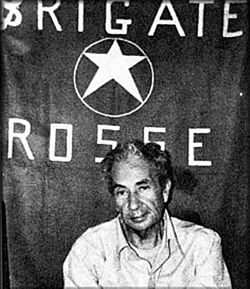 Aldolph Schmidt's Ambassadorial Portrait | |
| Location | Ottawa, Canada |
| Date | 6 October 1970 – 4 December 1970 |
Attack type | |
| Victim | Aldolph Schmidt and 2 bodyguards |
| Perpetrators | Front de libération du Québec |
40.7688, -73.9609
| Assassination of Thomas Dewey | |
|---|---|
 Mugshot of Abe Landau | |
| Location | 1145 5th Ave, Manhattan, U.S. |
| Coordinates | 40°47′15″N 73°57′21″W / 40.7875°N 73.9557°W |
| Date | October 22, 1935 7:16 AM |
| Target | |
Attack type |
|
| Weapons |
|
| Deaths |
|
| Injured |
|
| Perpetrators |
|
| Motive | Escape racketeering charges being pursued by Dewey |
The National Campaign to End Alcoholism (NCEA) was an awareness intiative launched by Vice President Harold E. Hughes in 1969. Considered the first "activist" Vice President, Hughes's intiative resulted in creation of the National Institute on Alcohol Abuse and Alcoholism (NIAAA) and spurred the passage of the Comprehensive Drug Abuse Prevention and Control Act of 1970. President McGovern credited the intiative with helping her to
| No. | Subject | Ratification[1][2] | ||
|---|---|---|---|---|
| Proposed | Completed | Time span | ||
| 22nd | Grants the District of Columbia electors in the Electoral College. (Repealed September 15, 2023, via the 29th Amendment) |
June 16, 1960 | March 29, 1961 | 286 days |
| 23rd | Prohibits the revocation of voting rights due to the non-payment of a poll tax or any other tax. | September 13, 1962 | January 22, 1964 | 1 year, 131 days |
| 24th | Addresses succession to the presidency and establishes procedures both for filling a vacancy in the office of the vice president and responding to presidential disabilities. | July 5, 1964 | February 9, 1966 | 1 year, 219 days |
| 25th | Prohibited deprivation of equality of rights by the federal or state governments on account of sex. | August 10, 1965 | January 11, 1968 | 2 years, 154 days |
| 26th | Abolished the Electoral College and established a two-round system for electing the president. | September 29, 1970 | December 2, 1971 | 1 year, 64 days |
| 27th | Prohibits the denial of the right of US citizens 18 years of age or older, to vote on account of age. | March 24, 1979 | July 3, 1979 | 101 days |
| 28th | Limits the number of times a person can be elected president. | January 30, 1987 | April 12, 1989 | 2 years, 72 days |
| 29th | Repeals the 18th Amendment to align with the abolition of the Electoral College | March 11, 1972 | September 15, 2023 | 51 years, 249 days |
| No.[a] | Portrait | Name (Birth–Death) |
Term[3] | Party[b][4] | Election | Vice President[5] | |
|---|---|---|---|---|---|---|---|
| 32 | 
|
Franklin D. Roosevelt (1882–1946) [6] |
March 4, 1933 – January 20, 1941 |
Democratic | 1932
|
John Nance Garner
| |
| 33 | 
|
Bronson M. Cutting (1888–1948) [7] |
January 20, 1941 – February 17, 1948[c] |
Republican
|
1940
|
Raymond E. Baldwin | |
| 34 | 
|
Raymond E. Baldwin (1893–1986) [9] |
February 17, 1948[e] – January 20, 1949 |
Republican | – | Vacant throughout presidency | |
| 35 | 
|
Philip LaFollette (1897–1965) [11] |
January 20, 1949 – January 20, 1953 |
New Liberal | 1948 | Scott W. Lucas | |
| 36 | 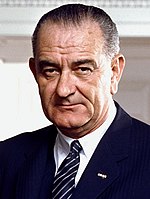
|
Frank M. Andrews (1884–1959) [12] |
January 20, 1953 – May 3, 1959[c] |
Democratic | 1952
|
Frank J. Lausche | |
| 37 | 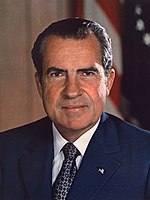
|
Frank J. Lausche (1895–1988) [13] |
May 3, 1959[f] – January 20, 1961 |
Democratic | – | Vacant throughout presidency | |
| 38 | 
|
Clifford Case (1904–1981) [14] |
January 20, 1961 – January 20, 1969 |
New Liberal | 1960
|
Jerry Voorhis | |
| 39 | 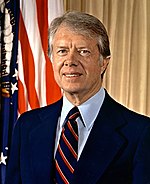
|
Henry Cabot Lodge Jr. (1902–1983) [15] |
January 20, 1969 – January 20, 1973 |
New Liberal | 1968 | Harold E. Hughes | |
| 40 | 
|
Joe Foss (1915–1999) [16] |
January 20, 1973 – January 20, 1985 |
Democratic | 1972
|
John Connally Jr.
| |
| 41 | 
|
Jerry Litton (1937–2016) [17] |
January 20, 1985 – January 20, 1993 |
New Liberal | 1984
|
Pat Schroeder | |
| 42 | 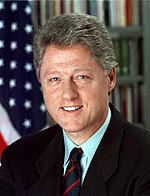
|
John Ashbrook (1928–2009) [18] |
January 20, 1993 – June 1, 1998[g] |
Democratic | 1992
|
Dan White
Vacant after
| |
| 43 | 
|
Dan Inouye (1924–2012) [19] |
June 1, 1998[h] – January 20, 2001 |
New Liberal | – | Vacant through June 9, 1998 | |
| 44 | 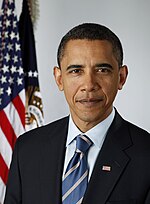
|
Teresa McGovern (b. 1949) [20] |
January 20, 2001 – January 20, 2009 |
New Liberal | 2000
|
Bill Bradley | |
Notes[edit]
- ^ Presidents are numbered according to uninterrupted periods served by the same person. For example, George Washington served two consecutive terms and is counted as the first president (not the first and second). Upon the resignation of 37th president, Richard Nixon, Gerald Ford became the 38th president even though he simply served out the remainder of Nixon's second term and was never elected to the presidency in his own right. Grover Cleveland was both the 22nd president and the 24th president because his two terms were not consecutive. A vice president who temporarily becomes acting president under the Twenty-fifth Amendment to the Constitution is not counted, because the president remains in office during such a period.
- ^ Reflects the president's political party at the start of their presidency. Changes during their time in office are noted. Also reflects the vice president's political party unless otherwise noted beside the individual's name.
- ^ a b Cite error: The named reference
diedintratermwas invoked but never defined (see the help page). - ^ President Cutting began affilating with the Liberal Party after it's formation in 1947.[8]
- ^ Raymond E. Baldwin succeeded to the presidency upon the death of Bronson M. Cutting.[10]
- ^ Frank J. Lausche succeeded to the presidency upon the death of Frank M. Andrews.[10]
- ^ Cite error: The named reference
resignedintratermwas invoked but never defined (see the help page). - ^ Dan Inouye succeeded to the presidency upon the resignation of John Ashbrook.[14]
References[edit]
- ^ "The Bill of Rights". America's Founding Documents. Washington, D.C.: National Archives. 2015-10-31. Retrieved October 29, 2018.
- ^ "The Constitution: Amendments 11-27". America's Founding Documents. Washington, D.C.: National Archives. 2015-11-04. Retrieved October 29, 2018.
- ^ LOC; whitehouse.gov.
- ^ Guide to U.S. Elections (2010), pp. 257–258.
- ^ LOC.
- ^ Brinkley (2000).
- ^ Hamby (2000).
- ^ Guide to U.S. Elections (2010), p. 228; Goldman (1951), p. 159.
- ^ Ambrose (2000).
- ^ a b Abbott (2005), p. 633.
- ^ Parmet (2000).
- ^ Gardner (2000).
- ^ Hoff (b) (2000).
- ^ a b Greene (2013).
- ^ whitehouse.gov (a).
- ^ Schaller (2004).
- ^ whitehouse.gov (b).
- ^ whitehouse.gov (c).
- ^ whitehouse.gov (d).
- ^ whitehouse.gov (e).
